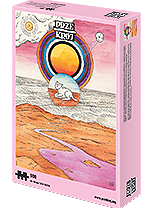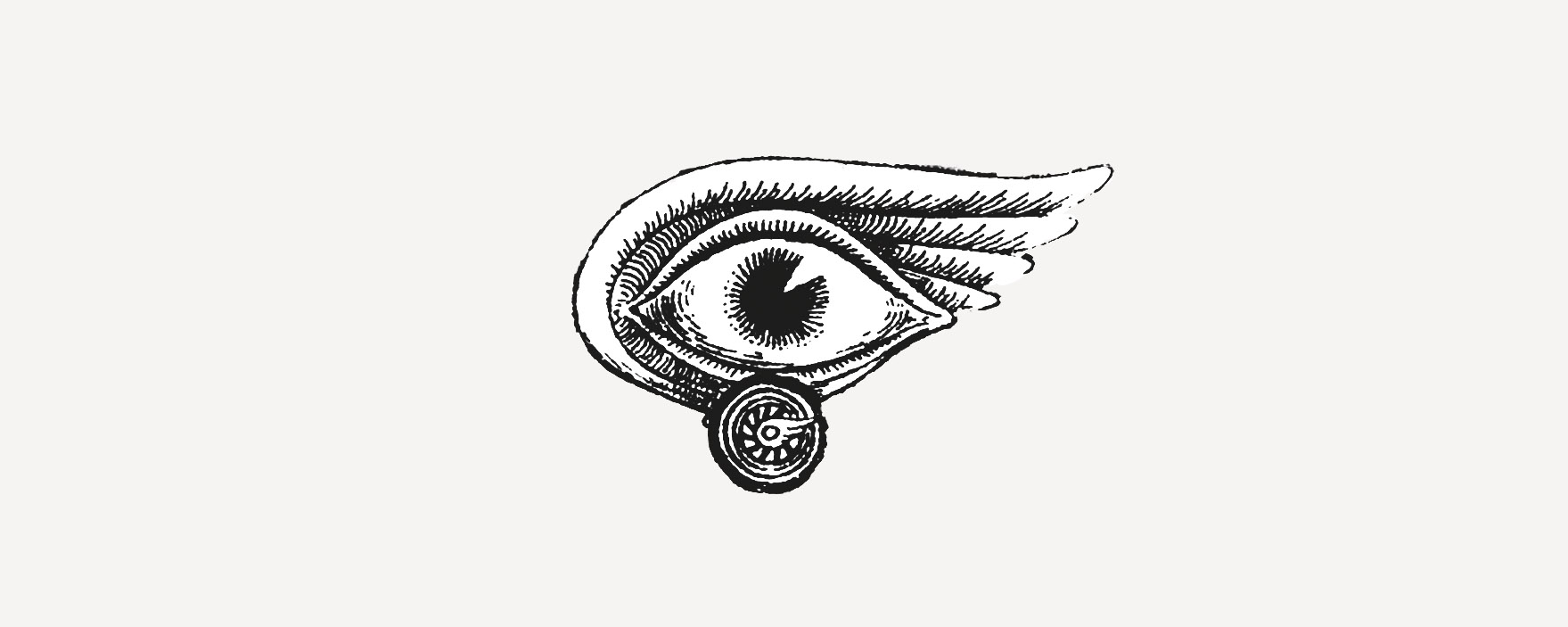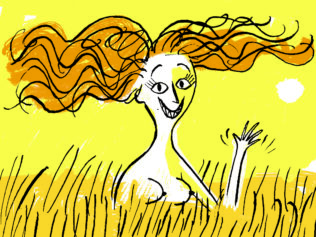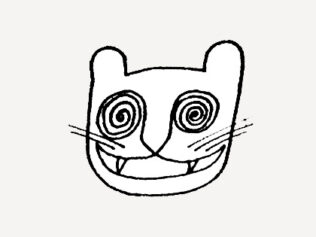
More than 1500 years ago, a few European philosophers and a large number of Egyptian peasants were driven out into the desert. They abandoned their families, cast off their clothes and surrendered themselves to fasting. They were tormented by demons that still afflict us today.
Visitors to the National Museum of Ancient Art in Lisbon can admire Hieronymus Bosch’s Triptych of the Temptation of St. Antony. And there’s a lot to admire. Antony, his hands folded piously, lying on his back and floating into the air on the belly of a winged toad; a procession of devils hurrying into a cave opening between the buttocks of someone standing on all fours; two women celebrating Mass; and among the creatures crowding around to take communion, a mandolinist with the face of a pig and an owl on his head. Antony surveys a table supported by naked demons. Like a parody of the Eucharist, the table holds bread and a cup with a pig’s leg protruding from it. Somewhere in the background, a village is burning. Looking at this painting, we ask ourselves: where is the temptation here? Why is Antony not being lured by the well-known charms of this world, but instead by hideous monsters and scenes of blasphemy and rape? What did the artist see in the saint’s history that made him decide to portray him surrounded by abomination and violence?
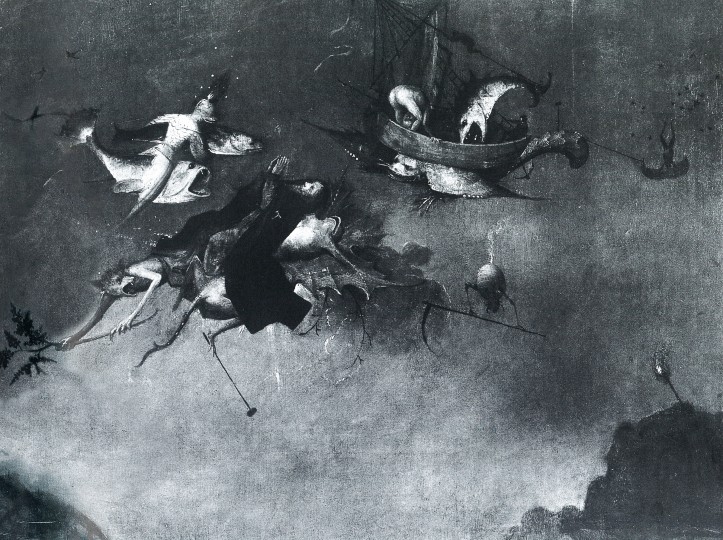
The road to the tomb
Antony’s story began quite innocently. He lived in Egypt from around 250 to 357 AD. His biographer, Bishop Athanasius of Alexandria, says that he was born in a small village to a fairly wealthy family. As Athanasius describes in Walter J. Burghardt’s The Life of Saint Antony, Antony was likely shy and withdrawn: “As a child he lived with his parents, knowing nothing but them and his home; and when he grew to be a boy and was advancing in age, he did not take to schooling, desiring to shun even the companionship of other children […]. Of course, he attended church with his parents […], he paid attention to the lessons that were read, and carefully kept in his heart the profit he gleaned from them.” When Antony was around 18 to 20 years old, his parents died. Orphaned, he was reluctant to deal with his inheritance. When he walked into a church one day and heard: “If thou wilt be perfect, go sell all that thou hast, and give it to the poor; and come, follow me and thou shalt have treasure in Heaven,” he felt that the words were directed towards him. He gave away his inherited land to peasants from his village. He sold his chattels and gave most of the money to the poor, leaving only a small sum for his younger sister. Later, however, he gave this away too, and placed his sister “with known and trusted virgins, giving her to the nuns to be brought up.”
At first, he settled near his village and decided to limit his needs as much as possible and to tend to his soul. It was then, according to Athanasius – the Bishop of Alexandria, and Antony’s disciple – that Satan immediately began to torment him. Initially, he was troubled by concern for his sister, remembering his personal habits and the convenience of having money. He was tempted by sex, which appeared in the form of a boy: “As he is in his heart, precisely so did he appear to him – as a black boy.” Antony, however, did not succumb to these beguiling tricks and managed to repulse all such occurrences. After some time, he decided to move further away from people and went to live in an old tomb in the desert. But the devil caught up with him there as well: “[…] he came one night with a great number of demons and lashed him so unmercifully that he lay on the ground speechless from the pain.” The man from the village who brought him bread looked after Antony and took him home with him. But when he recovered, Antony returned to the tomb, and the devil attacked him with redoubled power: “[D]emons were […] bursting through [the walls] in the forms of beasts and reptiles. All at once the place was filled with phantoms of lions, bears, leopards, bulls, and of serpents, asps, and scorpions, and of wolves. […] Antony, pummelled and goaded by them, felt even severer pain in his body; yet he lay there fearless and all the more alert in spirit.” Of course, the devil achieved nothing. Soon after, Antony went much further into the desert, stopping at an abandoned fortification called Pispir. He closed the gate and spent 20 years there in seclusion. Over time, people who wanted to imitate him gathered around his hermitage, and he became their teacher. He would sometimes travel for matters that were important to the Christian world. Finally, tired of this activity, he went even further into the desert to Mount Kolzim, from where he could see the Red Sea. He set up another hermitage. Again he battled with the devil and met with his students, until he died.
Own nothing, mortify yourself and avoid people
The idea of rejecting the ‘world’ – its goals, ambitions and everyday troubles – and the practice of radically disciplining bodily desires were known long before Antony. In the period preceding the birth of Jesus, this kind of life was chosen by the Essenes. One of the most emblematic figures representing the conduct of radical detachment from corporeality was Origen – an outstanding (though controversial for Orthodoxy) thinker of early Christianity, who died in 250 AD. As an 18-year-old who did not want to live ‘by the flesh’, he castrated himself. He never ate meat, drank alcohol or used oil.
However, after Antony, there was a rapid growth in the popularity of the hermit life. An expert on this phenomenon, Marek Starowieyski, writes: “[…] even if we reject as inauthentic the majority of the numbers given to us by sources that too easily operate with hundreds and thousands […], the mass nature of this phenomenon is unquestionable.” Many, many people abandoned their homes and fields to go to the desert and, alone or in communities of varying sizes, devote themselves to severe asceticism and prayer. The vast majority of them were Egyptian peasants, but among the Elders – or Fathers (Abba), as they were called – there were also people from various parts of the Christian world, including educated representatives of the elite, such as Arsenius and Evagrius Ponticus, the author of famous works on spirituality. The hermits rarely wrote anything down. However, in 385 AD, a man called John Cassian arrived in the desert – the author of Conferences of the Desert Fathers, which has been widely read in the Christian world. In the fifth century, there appeared a collection of sayings (Apophthegmata Patrum) and instructive anecdotes from their lives, the most famous of which is the Gerontikon, or The Book of the Elders, a classic of early Christian literature.
According to this text, to go out into the desert is to break with everything by which people live: “It was said of Abba Theodorus […] that he considered these three things the most important: own nothing, mortify yourself and avoid people.” A certain hermit once went into the desert, where he met a completely naked man who started to run away from him. Chasing after him, he threw off his own clothing. “The man being chased, when he saw that the chaser had thrown off his clothing, waited for him and said, ‘When you rejected what is from the world, I waited for you.’ That brother asked him, ‘Father, tell me a word, that I may be saved.’ He replied, ‘Avoid people, remain silent, and you shall be saved’.” The famous Abba Macarius once went into the desert, where he found two completely naked people at a waterhole for wild animals. The people told him they had been living that way for 40 years, that they were not harmed by cold or heat, and that if a person did not renounce everything that is in the world, they could not become a monk. That is why Macarius said that he himself was not a monk, but that he had seen monks.
Breaking with the world goes hand in hand with a radical dissociation from the body and its needs. The body symbolizes the world. Roots in it, dependence on it. One can talk endlessly of the mortifications of monks. Of eating once every two days, of a diet limited to herbs and roots, of someone who ate one fig and two plums per day, provided they were rotten. Of restricting sleep. Of drinking dirty water, of not washing…
Leaving the world is a bit like leaving life. For Antony and the others, the path from the human world to the world of the desert went via the tomb. Macarius slept in a tomb, using an old mummy as a pillow. There is a story about a nun who spent 38 years at the bottom of a cave. Old, unused pagan temples also served as shelters. For the hermit – as for Jesus – the tomb into which he descends becomes a gateway to a new life. In the tomb the body should be transformed, readied for rebirth. But first, like Jesus, the hermit must descend into hell.
Escaping from the world, descending into the tomb and going out into the desert do not mean freeing oneself from worries and afflictions. On the contrary, it is in the desert that the most difficult trials arise. In his monograph about the devil, Alfonso di Nola reminds us that in the desert, having abandoned a safe life in Egypt, the Jews came face to face with God himself. It is in the desert that Jesus stares into the eyes of Satan, who leads him into temptation. Antony and his followers, going out into the desert to escape from the temptation of the body, had to face even more terrible temptations – those of the mind.
The eight evil thoughts
In stories of the lives of the Desert Fathers, the devil is ubiquitous. Demons take the form of animals, humanoid beings with superhuman dimensions, and beautiful women who lead monks into temptation (sometimes successfully) or wreak havoc by pretending to be angels. Antony was visited by the devil in the form of a centaur. For one elder, who had valiantly rid himself of evil spirits over a long period of time, the devil appeared in the form of Christ. “Seeing him, the elder closed his eyes. The devil said, ‘I am Jesus Christ, why do you close your eyes?’ The elder replied, ‘I don’t want to see Christ here, but in the next life.’ When the devil heard this, he vanished.”
These visions can be dismissed as hallucinations of a mind tormented by fasting, insomnia and heat. According to depth psychology, however, wild animals appearing in dreams are manifestations of traumatic affects experienced by the dreamer. The monsters that persecuted Antony and the others say a lot about the feelings hidden in the haggard bodies of the hermits. We can only marvel at the strength and danger of those affects that explode when no borders are imposed on them in the desert.
Evagrius tells us a lot about the emotional experiences of the monks in a treatise on the eight evil thoughts, based on his own experiences and observations of others. He does not talk of hellish circles, nor does he flaunt his esoteric knowledge of the names of demons – instead, he writes about gluttony, pride, lust, avarice, dejection, anger, despondency and vainglory. Despondency is particularly destructive when, as Szymon Hiżycki writes in his interpretation of the thinking of Evagrius, a demon reveals to a man his life as a complete disaster. It is this idea of one’s own life that is the most dangerous trap. According to Evagrius, “the northern wind makes the young branches immune, and temptations strengthen the soul.” But despondency destroys everything. Despondency is caused by the “demon of the south”, which plagues the monk from 10 o’clock in the morning until two in the afternoon. It gives the impression that everything has stopped in its tracks, that the sun is not moving. As Di Nola wrote, the monk is possessed with impatience, beginning to “feel hatred for life and work, and the demon tries to get him to leave his cell.” Evagrius wrote that: “The gaze of one who submits to despondency is always on the window, and his mind conjures up visitors.” He is tormented by uncertainty and frustration, he cannot concentrate on anything, nor sit in one place. He would like to give up what he has, go somewhere, discover new opportunities. Who knows? Maybe he suffered from despondency beforehand? Maybe that’s what drove him into the desert? The erudite Evagrius could not bear his life and his promising career. One day he had a “terrible dream”, after which he decided to become a hermit. The Egyptian peasants were disenchanted with their life of poverty and fled from it into the desert, where it happened that, thanks to the sacrifices and respect of the faithful, their material and social status was higher than if they had remained on their meagre farms.
In the desert, there was also freedom to simply go crazy. To walk around naked, drink water with wild animals, and dream up unusual fantasies about sex or fights with superhuman opponents. To believe in your own deification. One of the better-known fathers, John Colobus, once thought that he would live like an angel. He cast off his clothes and went into the desert, but after a week he returned. When he knocked on the door, the monk with whom he had lived did not open up, but asked: “Who’s there?” When he said, “It’s John, your brother,” the other replied: “John became an angel and is no longer among men.” It was only after many hours that the monk let him in and said: “Since you are, however, a man, you should work for your own upkeep again.” John fell to the ground and apologized.
Why all the fear and anger?
But it is not enough to say that the visions and extravagances of the Desert Fathers were an expression of suppressed feelings and desires. If we look at them closely, we can see an important resemblance to the experiences of the patients of Freud, Jung and their successors. Not to liken the experiences of Egyptian hermits to mental disorders, but to better understand where they came from. In the book The Inner World of Trauma, the contemporary Jungian analyst Donald Kalsched writes about a figure that would often come up in patients’ accounts – a satanic man with an axe, a murderer with a weapon, or the devil himself. The fear of this figure prevents them from living an active life. It terrorizes them, but it also protects them from something even more terrible. Before the trauma that marked their lives to such an extent that the world of frightening fantasies seems safer than real life. But Kalsched also writes that: “The diabolical inner figure is often far more sadistic and brutal than any outer perpetrator, indicating that we are dealing here with a psychological factor set loose in the inner world by trauma – an archetypal traumatogenic agency within the psyche itself.” Some experience awoke a dark force in the psyche of the heroes of the Gerontikon, whereby they preferred to escape into the desert rather than remain in the human world. Perhaps this is the power that Abba Arsenius had in mind when he confessed before his death: “The fear that I’m experiencing now has always been with me. That is what made me become a monk. I am very scared.” How much of this force is fear and how much is anger? “Abba Ammonas said, ‘I spent forty years in Sketis, begging God day and night to give me the grace to control my anger.’”
Anger and fear make people run away from others, torment the body, and dream up visions full of terror and illusions of their own greatness. Antony sensed a trap. He once said: “I saw all the snares of the enemy spread out on the ground, and I moaned and said, ‘But who will escape them?’ And I heard a voice saying to me, ‘Humility’.” It is also said that, “unable to comprehend the depths of God’s judgments, he asked, ‘Lord, why do some people die in their youth, and others live until old age? Why do some people live in poverty and others have great wealth? Why do the unjust prosper and the righteous suffer misery?’ And he heard a voice: ‘Antony, attend to yourself, for it is not right for you to know the divine decree.’” It is as if the voice had told him, Antony, instead of assessing and judging, look at all the bad things around you, look at yourself and think about where all your fear and anger come from.
Maybe this was the temptation that Bosch wanted to communicate when he painted his famous triptych. The temptation to surrender to your fear and anger, to accept a promise of security from a dark, archetypal power, which makes you see evil and abomination all around, despise people, and no longer value your own life.
Fortunately, the story of the Desert Fathers does not end there. On one occasion, while praying, Abba Macarius heard a voice: “Macarius, you have not yet achieved the standard of perfection of two particular women in this city.” Macarius went to that city at once, he found the two women and asked them about their good deeds. In surprise, they said: “We have husbands, we live with them. All we can say about ourselves is that we do not remember ever having argued with each another or saying a bad word about each other. And we promised ourselves and God that no secular word would ever pass our lips.” That is all that Macarius learnt. He went home, perhaps reflecting on the extent to which one has to come to terms with oneself in order to live in harmony with another human being. So as not to be scared. And that this was a much more important task than all the battles with his own body and the devil that he had been heroically fighting in the desert for so many years. And that this was the only way for a life not to be a failure.
Translated from the Polish by Kate Webster

